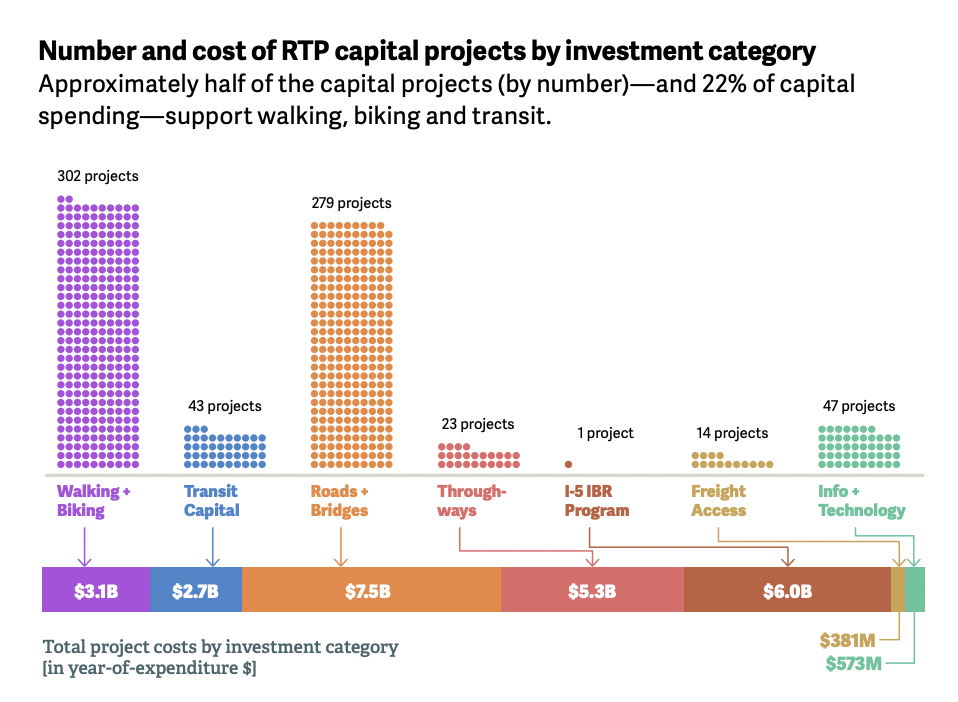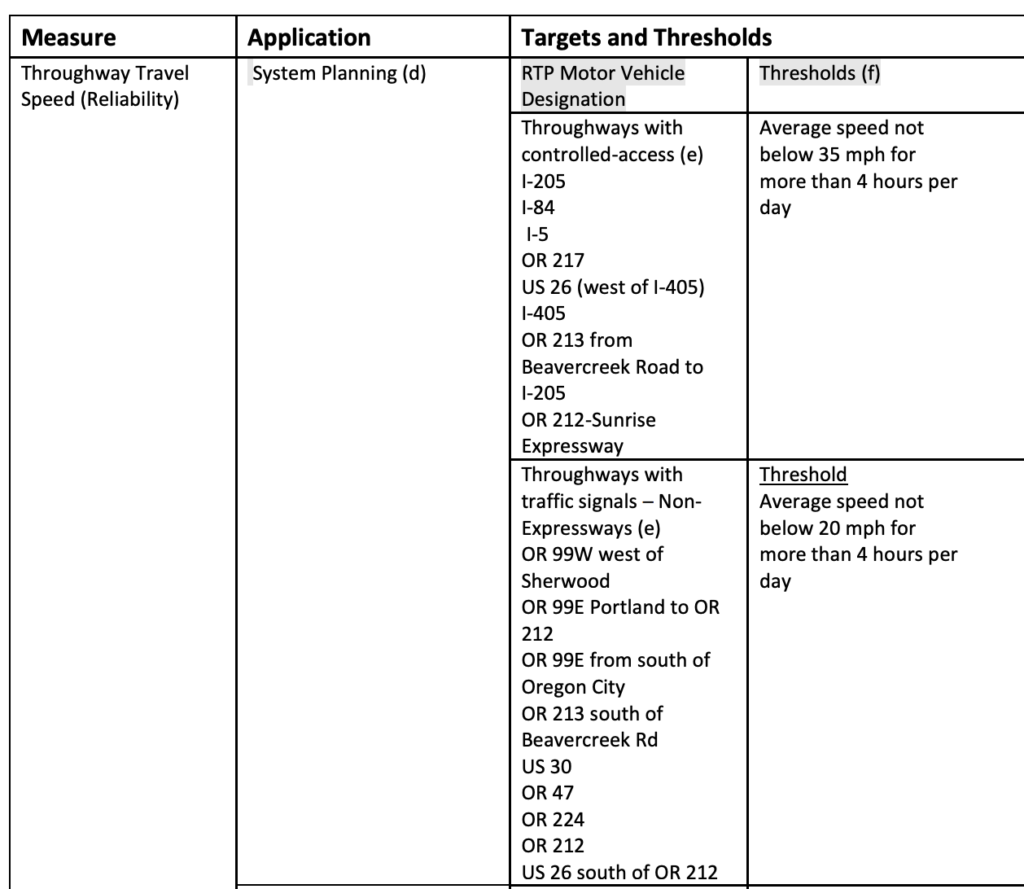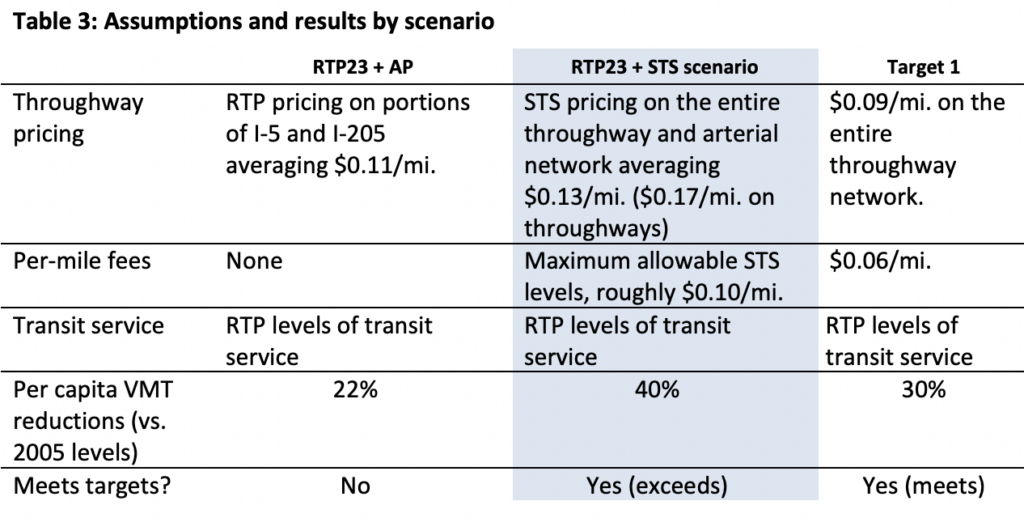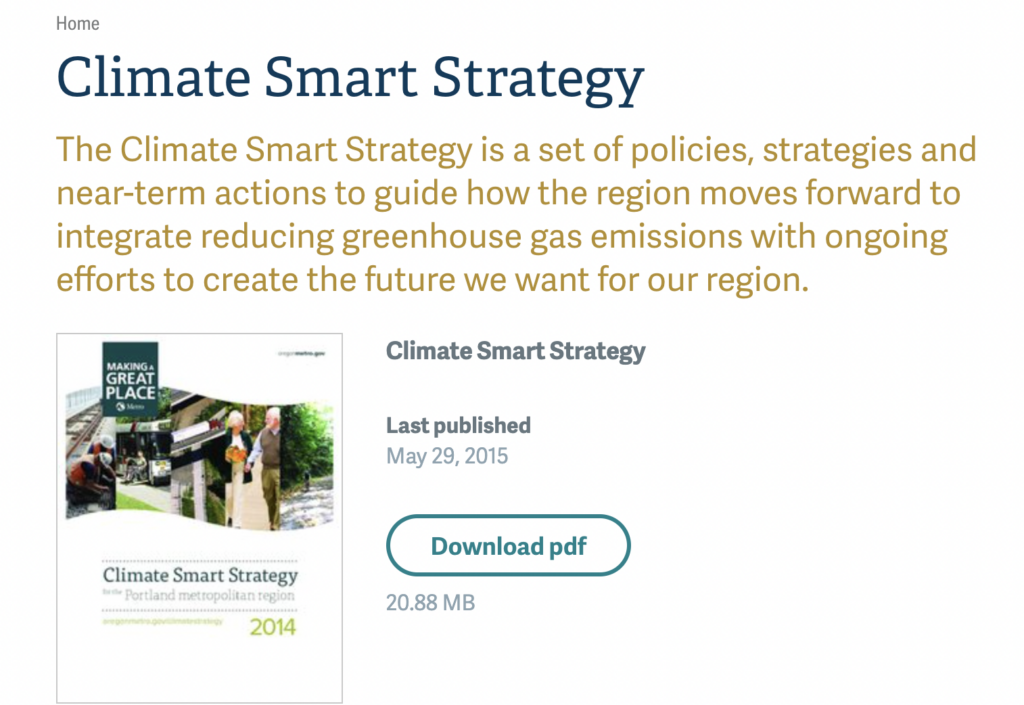Portland Metro’s Regional Transportation Plan (RTP) does nothing to prioritize projects and expenditures that reduce greenhouse gases
Metro falsely asserts that because its overall plan will be on a path to reduce GHGs (it wont), it can simply ignore the greenhouse gas emissions of spending billions to widen freeways
The RTP’s climate policies don’t apply to individual project selection; projects are prioritized on whether they reduce vehicle delay—a failed metric it uses to rationalize capacity expansions that simply induce additional travel and pollution
The RTP environmental analysis falsely assume that ODOT will impose aggressive state charges on car travel, including carbon taxes, a mileage fee and congestion fees than have not been implemented, and may never be, to reduce VMT
The RTP’s traffic modeling fails to incorporate the effect of expected pricing on the need for additional capacity. Modeling done by ODOT shows that pricing would eliminate the need for capacity expansion, saving billions, and reducing greenhouse gases.
Transportation is the largest and fastest growing source of greenhouse gases in the Portland Area; every one of the state, regional and local plans to reduce transportation greenhouse gases is clearly failing. The proposed 2023 Regional Transportation Plan could be a vital tool for prioritizing actions to reduce transportation GHGs. It isn’t. It’s a vehicle for justifying a multi-billion dollar wish list of road projects, and pretending that someone else will solve the climate problem. The plan does nothing to use climate criteria to prioritize spending decisions, and instead, gives a pass to expensive road expansion projects that will encourage more driving and higher levels of greenhouse gases.

State and regional transportation plans fail to acknowledge the grim reality of increase transportation greenhouse gases (GHGs). As we’ve documented at City Observatory Metro (and others) have concealed the fact that transportation emissions are increasing by ignoring actual inventory data, and instead, reporting fictional results obtained from their own models, that ignore actual emissions information, and instead make rosy and unsupportable assumptions about future technology, market trends and policy. In essence, these plans pretend that transportation GHGs are already decreasing, and will decrease even more dramatically in the future.
RTP Priority: Billions for highway construction and expansion
The Regional Transportation Plan is an official, federally required planning document that spells out how the region will invest in transportation over the next two decades. This is exactly the time when scientists tell us we must take decisive action to reduce greenhouse gas emissions. But the largest projects—and the bulk of the expenditures—in the RTP are highway construction and widening that will facilitate more car travel, and increase greenhouse gas emissions.
The RTP document tries to downplay the emphasis on road building with a misleading graphic that shows dots for each project. The massive Interstate Bridge Replacement is one tiny dot, the huge Rose Quarter widening one tiny dot, the I-205 Abernethy one tiny dot—even though these represent more than $10 billion in capital spending.
The fine print text acknowledges that this is mostly a few big highway projects, but even then substantially understates their true costs. The Executive Summary fine print says:
. . . the “big three” projects—the I-5 Interstate Bridge Replacement Program, the I-5 Rose Quarter Project, and the I-205 Widening and Toll Project—each cost more than $1B.
In fact, the estimated price tag for the IBR is as much as $7.5 billion, the Rose Quarter project has ballooned to $1.9 billion. . The RTP neither reflects the current cost estimates of these projects, nor the likely costs of further cost overruns, which are endemic on major ODOT highway projects.
The RTP spends bulk of its capital on projects that add capacity to freeways—even though a decade old Metro climate plan conceded that these have “low”impact on reducing GHGs. And in fact, all of the available science on induced demand shows that added capacity increases driving, and increases emissions.
How can Metro square spending billions on highway widening with the climate crisis? As we pointed out earlier, Metro has ignore the actual inventory data showing increasing transportation greenhouse gas emissions, and substituted its own demonstrably wrong emission modeling to assert we’re on track to reduce greenhouse gas emissions.
Then the policies in the RTP use this umbrella assertion that “this is fine” to simply ignore the greenhouse gas emission effects of individual projects. The result is a “drive and pollute as usual” approach to the region’s transportation spending plans and policies. The bureaucrats assert that because their models show that the overall plan will (based on wildly wrong assumptions) make progress toward the 2050 state goal, that there is essentially no need to rank or prioritize investments based on whether they increase or decrease greenhouse gas emissions. Meeting the greenhouse gas reduction goal is a criteria applied only (and falsely) to the overall regional plan, and not to any specific projects.
This umbrella claim that the RTP as a whole RTP meets the state climate goals, is spelled out in policy:
Vehicle miles traveled (VMT)/capita will be a controlling measure in both system planning and plan amendments to ensure that the planned transportation system and changes to the system support reduced VMT/capita by providing travel options that are complete and connected and that changes to land use reduce the overall need to drive from a regional perspective and are supportive of travel options.
• For system planning, the final planned system must support OAR 660 Division 44 (Metropolitan Greenhouse Gas (GHG) Emissions Reduction rule) and OAR 660 Division 12 VMT reduction targets.
• For plan amendments, VMT/capita will be used to determine whether the proposed plan amendment has a significant impact on regional VMT/capita that needs to be mitigated or not.
System completeness and travel speed reliability on throughways are secondary measures that will be used to identify needs and inform the development of the planned system.
“Controlling measure” sounds imposing, but this is deceptive. In effect, the VMT reduction goals apply only to the overall plan, and to amendments to the plan. Projects included in the plan are given a pass on whether they increase or decrease VMT (and greenhouse gas emissions). While VMT is labeled as “a controlling measure” and travel speed is described as a “secondary measure,” the language of the RTP conceals the fact that the secondary measure really determines the priority for spending. The RTP prioritizes project spending based on travel speed, not reducing VMT or greenhouse gases.
The RTP doesn’t prioritize spending money on projects that reduce VMT. The RTP contains only a requirement that plan amendments that increase per capita VMT have to be “mitigated.” That’s problematic for a couple of reasons. First: several huge freeway widening projects are included in the plan itself, and aren’t amendments, so they won’t be mitigated at all. Second, Metro claims that its models can’t actually detect whether projects—even very large ones, like the IBR or Rose Quarter Freeway widening—increase VMT. Third, ODOT (falsely) claims that highway expansions don’t increase VMT. Metro has not adopted any objective third party method for assessing per capita VMT effects of projects—like the CalTrans adopted induced travel calculator. ODOT’s own technical manual simply denies the existence of induced travel and bars its inclusion in ODOT modeling). Finally, the policy doesn’t limit or ban plan amendments that increase per capita GHG emissions—it only requires that increases be mitigated. (The RTP fails to say where the mitigation will come from, especially if the region is actively implementing other ways to reduce VMT).
RTP travel speed standards prioritize projects to increase capacity
What the RTP does do, however, is create a rigid standard prioritizing travel speeds on throughways and arterials. Throughways need to provide no less than 35MPH at least 20 hours per day; other “signaled” arterials must provide at least 20MPH no fewer than 20 hours per day. These speed standards do apply to the prioritization of project spending. While they are labeled as “secondary” these are in fact the “controlling” metrics for project selection and prioritization.
Again, in contrast, the climate standards, calling for a reduction in VMT effectively only apply to the overall plan, not segments thereof, and only have to “support” possible VMT reductions, not actually result in them.
In sum, individual investments, even ones as large as the multi-billion dollar widenings of I-5 at the Rose Quarter and the Interstate Bridge are effectively exempt from any climate analysis. Climate simply doesn’t matter for setting regional spending priorities. The only thing that matters under the terms of the Regional Transportation Plan (RTP) is whether investments speed traffic. The RTP sets a goal of making sure that area “throughways” travel at no less than 35 MPH 20 hours per day, and that area arterials travel at no less than 20 miles per hour for 20 hours per day.
Projects that speed traffic on highways have been proven to increase travel—a widely documented scientific finding called “induced travel” which means that wider roadways generate more vehicle miles of travel and more pollution.
The Metro RTP criteria give no additional weight or priority to projects that reduce transportation greenhouse gas emissions. Speed, not greenhouse gases or safety, drives the distribution of resources under the plan.
RTP climate compliance depends on imaginary, unadopted policies
A key climate question is whether the region will reduce VMT. The RTP contains little, if any information, on which of its investments will reduce VMT. It makes a sweeping and general claim that providing transit (and other alternatives) “create the conditions” that could reduce VMT; but lower VMT has to come from reflecting back to drivers the true costs associated with their decisions. When it comes to such actual financial incentives, the bottom line is that Metro assumes that as yet unadopted, and highly speculative state policies, not anything in the RTP, will reduce VMT.
The RTP counts on reduced driving as a result of ODOT and other state policies to make driving more expensive. There’s an old economist joke, about how to solve the problem of opening canned food when one has no means to do so; the economists waves the problem away, saying “Assume we have a can-opener.” Metro assumes that ODOT will produce a can opener in the form of a plethora of new fees on driving, including an unspecified carbon tax, a per mile fee of 6 to 10 cents per mile on all driving in the state, as well as a 9 to 17 cent per mile congestion fee for using throughways (limited access roads in Portland), plus tolls to finance the Interstate Bridge and I-205 bridges. The RTP climate analysis assumes that the state will enact all these fees, and this will reduce driving and carbon emissions.
In effect, the RTP is overwhelmingly dependent on the purely hypothetical actions of others to achieve climate goals: It depends on state and federal fuel economy, vehicle emissions and fuel policies to reduce emissions per mile driven, and depends on state imposed taxes and fees to reduce vehicle miles traveled.
If the state doesn’t take these actions—and while they would be smart policy, there is no guarantee it will do so—then the hoped for (and modeled) changes in VMT and greenhouses gases simply won’t occur. But there’s nothing in the plan to pick up the slack, and meanwhile these dubious assumptions will have rationalized spending billions of dollars of irreplaceable public capital on projects that increase driving (just as the climate crisis grows worse).
Failure to include pricing in transportation demand modeling and project evaluation
There’s a profound contradiction in the RTP’s treatment of road pricing. When it comes to climate strategy, and funding adequacy, the RTP assumes that pricing is a done deal. When it comes to modeling traffic demand, and especially the need for added capacity, it simply ignores the effects of pricing.
The work that has been done on pricing shows that if the state implements any of the proposed pricing mechanisms (Regional Mobility Pricing or RMPP; tolling on the I-205 Abernethy Bridge or the Interstate Bridge), the region will not need to build any new capacity. A particularly stark analysis was prepared by ODOT consultants showing that highway pricing (the RMPP) alone—and leaving the Rose Quarter in its current configuration—would be more effective in reducing traffic delays, congestion, VMT and greenhouse gases than spending $1.9 billion widening this 1.5 mile stretch of roadway. Yet Metro has refused to examine the greenhouse gas implications of these project alternatives, and won’t even apply such tools to project evaluation.
The strategy assumes that the state and region institute a stringent per mile pricing of freeways and arterials for purposes of estimating climate compliance, but the transportation modeling used to justify new project and capacity assumes that the roads are unpriced.
New revenue mechanisms in the STS include a road user charge that levies per-mile fees on drivers, carbon taxes, and additional road pricing beyond what is currently included in the 2023 RTP. These changes are not reflected in the RTP because they are not yet adopted in state policies or regulations, but the climate analysis for the RTP is allowed to include them because these state-led pricing actions are identified in STS and were assumed when the state set the region’s climate targets.
(Emphasis added).
The net effect of including the effects of as-yet-unadopted pricing for climate analysis, but not including it in travel demand analysis for capacity expansion projects, is to create a falsely optimistic picture of climate progress, and a falsely exaggerated picture of the need for additional capacity.
The Cop-Out: We’re following state rules
Metro’s RTP asserts that “this is fine” for climate because they are following LCDC rules for their land use plan which are designed to address climate change. LCDC has adopted a “Climate Friendly and Equitable Communities” (CFEC) rule that requires Metro to plan to reduce VMT. The key problem is that the CFEC rule is based on the same flawed ODOT analysis as the Metro RTP: making wildly unsupportable assumptions about the rapid adoption of clean vehicles.
Complying with the LCDC rule doesn’t put the region on track to reduce driving or transportation greenhouse gases, and doesn’t demonstrate how we will comply with the legally adopted state goal to reduce greenhouse gases to 25 percent of 1990 levels by 2050:
468A.205 Policy; greenhouse gas emissions reduction goals. (1) The Legislative Assembly declares that it is the policy of this state to reduce greenhouse gas emissions in Oregon pursuant to the following greenhouse gas emissions reduction goals:
. . . (c) By 2050, achieve greenhouse gas levels that are at least 75 percent below 1990 levels.
Instead, Metro asserts that its RTP conforms to LCDC regulations governing land use plans. The RTP makes no mention of ORS 468A.205.
Both the LCDC rules and the Metro RTP are based on badly flawed modeling of greenhouse gas levels. The modeling makes a series of incorrect and unsupported assumptions about vehicle fuel efficiency and emissions reduction technology. As a result, the modeling wildly understates the actual level of greenhouse gases produced by transportation, and wildly overstates the current and future reductions in greenhouse gases due to greater efficiency.
The 2022 LCDC “Climate Friendly and Equitable Communities” Rule relies on 2016 modeling prepared by former ODOT employee Brian Gregor. These figures have not been updated, despite a legal requirement that they do so.
Metro claims to have done additional modeling with its “Vision Eval” model. That modeling assumes that average vehicle ages fall to less than seven years, and that passenger cars make up more than 70 percent of household vehicles. As we’ve demonstrated both these assumptions are not only wrong, market trends are moving in the opposite direction of Metro’s forecast: cars are getting older and larger, not smaller and newer (and cleaner) as assumed.
Metro is counting on improved vehicles and fuels for more than 90 percent of greenhouse gas emission reductions. Appendix J of the RTP projects that the plan (which relies on pricing which is still speculative) will result in an 88 percent reduction in transportation GHG, with 81 percent reduction from fuels and vehicles, and 7 percent reduction from reduced VMT. That means that 92 percent (81/88) of the reduction in greenhouse gases comes from policies other than those in Metro’s RTP.
These heroic and wildly exaggerated assumptions about improved vehicle fuel efficiency enable Metro to plan for only an extremely modest reduction in VMT.
The RTP is climate denial
Metro leaders talk a good game about climate. They point to their nearly ten-year old Climate Smart Strategy. They acknowledge the reality of climate change, and the general need to reduce greenhouse gases. They’ve listened to national experts who point out the problems with traditional planning approaches.
In spite of all this, the RTP remains what it has always been, a highway-centric spending wish list. All this version does, is add on an additional layer of rationalization to insist that the region continue building roads on the elaborate and plainly false assumptions that cars will become vastly cleaner, and ODOT will aggressively price roads and carbon. The plan is still replete with billions of dollars of spending to increase highway capacity, including the $7.5 billion Interstate Bridge Replacement Project and the Rose Quarter. These highway expansions facilitate continued car dependence and increased greenhouse gas emissions.
Like Metro’s so-called Climate Smart Strategy, the climate provisions in the RTP are a at best an afterthought, and a performative fig-leaf, meant to provide rhetorical cover to a vast investment strategy that is fundamentally at odds with reducing greenhouse gas emissions.
Metro has promised to update its “Climate Smart Strategy” from 2014, but in fact it hasn’t.
Clicking on the “climate smart strategy” link and it takes you to a nine-year old document that hasn’t been updated. This is what still appears on the Metro website.
Metro’s real climate strategy is “Don’t look up.”
Metro’s RTP needs to examine the travel impacts of tolling and new capacity expansion
Metro claims that its travel modeling can’t really discern the effects of tolling on regional travel patterns, and instead of specific quantitative outputs it simply offers a series of descriptive, generalized statements—”qualitative findings”— about the impact of tolling.
The large-scale, aggregate nature of Metro’s travel model makes it challenging to detail the regional impacts of any single project, even one as potentially significant as tolling. Instead of attempting to isolate the impacts of tolling, Metro staff identified several qualitative findings about tolling’s impacts based on the modeling results for the constrained RTP scenario and on Metro’s experience supporting tolling analyses in the region
System Analysis Public Review Draft 2023 Regional Transportation Plan | July 10, 2023(Chapter 7, p. 7-7-28).
It is, in fact, possible and proven to estimate the effect of new highway capacity on travel patterns and greenhouse gas emission.sIn contrast, California and CalTrans have developed and created tools specifically to analyze the carbon impacts of individual projects: The Induced Travel Calculator. This calculator has been adapted to Oregon by the Rocky Mountain Institute. Metro could use this calculator to estimate the carbon associated with highway expansion projects. But ODOT, in a bit of science-denial, the Oregon Department of Transportation has specifically banned the used of induced travel analysis in state highway modeling.






